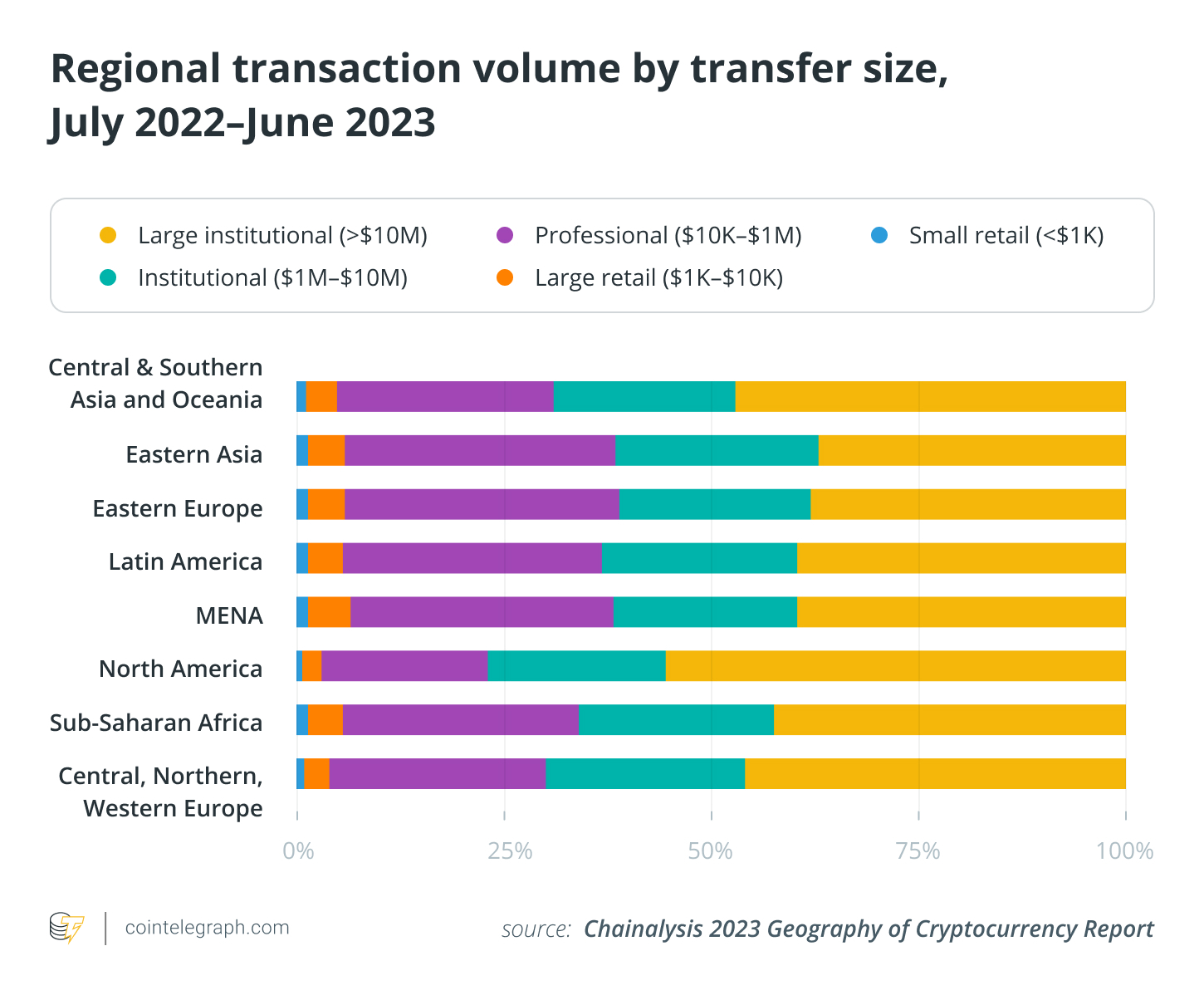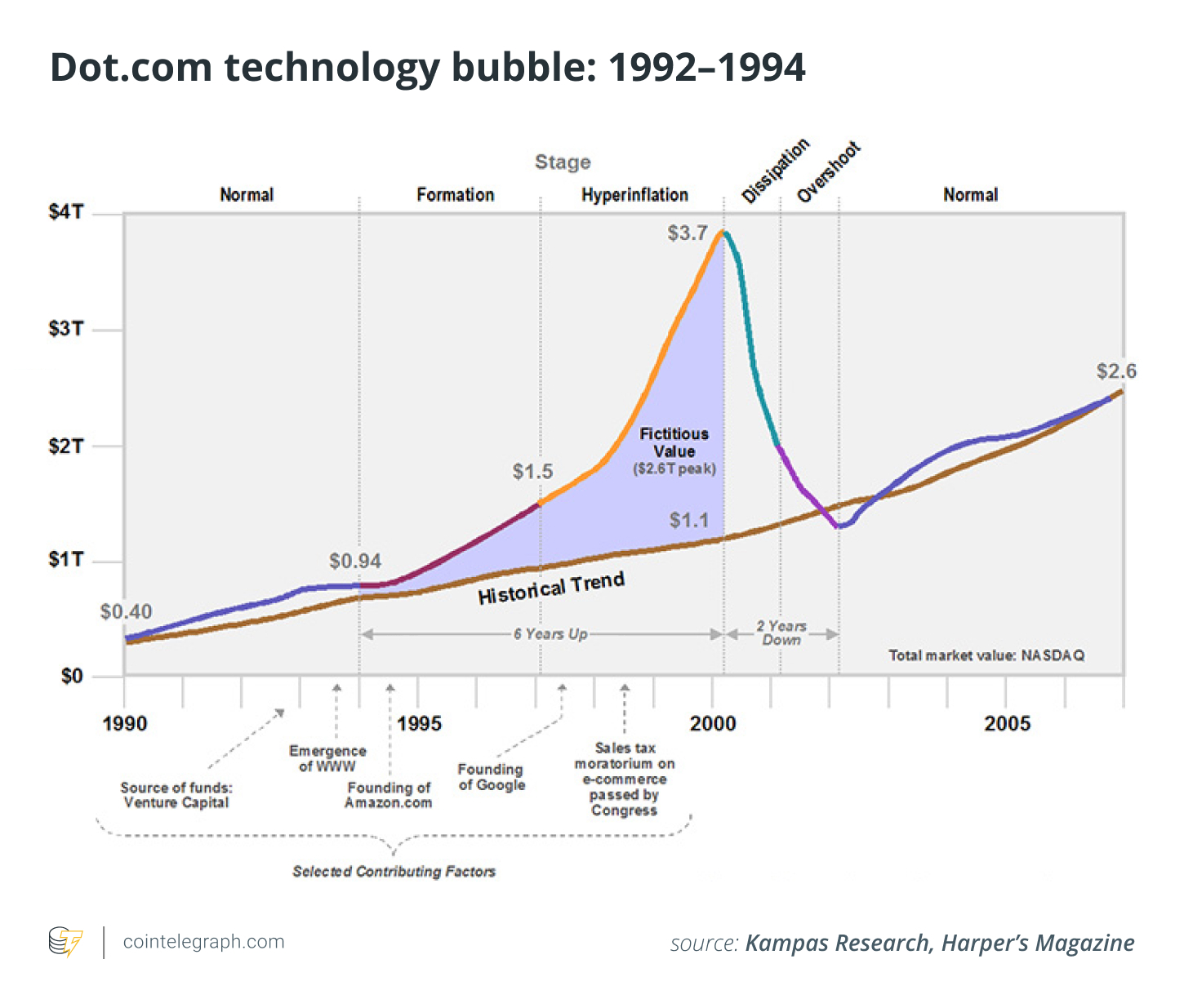The conventional wisdom of the cryptoverse is that there is a boom-and-bust cycle to the blockchain and cryptocurrency industry. This cycle is led by the “King of Cryptos,” Bitcoin.
Bitcoin (BTC) is programmatically set to have a halving cycle roughly every four years, which cuts the supply of new coins awarded to miners in half. The halving sends a supply shock to the market, and as seen in the past three cycles, this under- and overvaluation in the market is partially responsible for the dramatic ups and downs.
Other factors also play critical roles in this cycle, including overall network adoption, expanded use cases for Bitcoin — like the Lightning Network for scalability and Ordinals for nonfungible tokens — and the ever-popular “institutional adoption.”
In 2020, Dan Held, a Bitcoin educator and marketing adviser for Trust Machines, predicted that Bitcoin would eventually see a “supercycle,” citing the increased value of the network as adoption grows (Metcalfe’s law), increased scarcity due to the halving and increased institutional adoption.
This supercycle will, theoretically, see Bitcoin run up to new all-time highs, from which there will be no further downside, as there will be enough adoption and institutional support to continue to prop up the price.
Crypto winter sets in at the end of 2021
This support did not occur in the last cycle, and Bitcoin fell from its all-time high of $69,000 at the end of 2021, bringing the rest of the market down with it. All those factors of reduced supply, greater network growth, and more business and institutional support were not enough to support the meteoric rise.
Institutional support was growing so much during the last leg of the cycle that exchange-traded funds (ETFs) were approved around the world. The first physically-backed BTC ETF was launched in Canada in February 2021 by Purpose Investments.
Since then, Canada has also approved the CI Galaxy Bitcoin ETF and Evolve Bitcoin ETF. In Germany, there is the ETC Group Physical Bitcoin ETF, while Brazil and Australia also launched spot Bitcoin ETFs in 2021 and 2022. Yet these products did not provide the institutional support many believe will come from ETFs.
However, the various stock markets worldwide do not compare to the United States.
The European Union makes up 11.1% of global equity markets, while Australia and Canada make up 1.5% and 2.7%, respectively. All these markets combined are dwarfed by the United States, which comprises 42.5% of all global equity markets.
This does lend some weight to the idea that this cycle may hold the promise of Held’s “Bitcoin supercycle,” as the largest country in all global equity markets may soon allow spot Bitcoin ETFs to trade.
BlackRock, one of the most prominent names in asset management and investment circles, applied for its own spot Bitcoin ETF in June 2023, providing a kind of green light for other intuitions to start getting involved. However, institutions are only one factor here.
Adoption may be an emerging market trend
According to Chainalysis’ recent “2023 Geography of Cryptocurrency Report,” India, Nigeria and Vietnam were the top three countries for crypto adoption in 2023. The rankings were based on an index score that looked at centralized services, retail services, peer-to-peer (P2P) exchange trade volume, decentralized finance (DeFi) and retail DeFi value received.
The U.S. makes up North America’s largest percentage of transaction volume, and the country ranked fourth overall. As the chart below shows, North America had the largest percentage of large institutional transfers but some of the lowest amounts of small and large retail.
Recent: Former Coinbase exec posits blockchain-driven vision of future societies
This differentiation is important, as the market value of a commodity is not derived from centralized entities but rather from decentralized independent actors perceiving value in the commodity. As the Chainalysis report and Cointelegraph Research’s recent “Investing in DeFi” report suggest, investing in Bitcoin and other cryptocurrencies is akin to emerging markets investing at this stage in the adoption cycle.

Participants, not institutions, bring value
While institutional adoption will undoubtedly be an essential factor if and when the Bitcoin supercycle takes hold, Bitcoin itself needs to have perceived value from market participants, or it will not have the staying power. History is replete with examples of thriving industries that were superseded by a new technology the market found helpful and that toppled giants practically overnight.
The introduction of petroleum products completely overturned the whaling industry in the mid-1800s. There was a vast industry and institutions behind global whaling interests with boats, trade and infrastructure. Still, no matter how much money was behind it, the market saw better use with the new products.
More recently, and closer to the technological innovation led by the blockchain revolution, the dot-com bubble of the mid-1990s and early 2000s saw various companies overvalued. Part of the overvaluation was based on the assumption that adoption would be more rapid than what actually happened.
Signals such as the internet browser Netscape seeing 3 million downloads in three months had investors excited about what the rest of the industry could do.
In 1995, Netscape had a successful initial public offering, backed by institutions like Morgan Stanley, which pushed the stock price from $14 to $28 — valuing the not-yet profitable 16-month-old company at over $1 billion.
Investors kept looking for the next Netscape among the slew of Silicon Valley companies, and money poured into the space. In economics, the very height of the boom cycle, where overvaluation is at its apex just before the bust, is called the “Minsky moment.”
The dot-com bubble’s Minsky moment came in 2002. There was a ton of investor sentiment and institutional money flowing around, but there was no underlying adoption of many of the companies that saw investments. Nothing was ultimately there to support these companies and their value.
The Nasdaq Stock Market rose dramatically between 1995 and 2000, peaking in March 2000 at 5,048.62 before falling 76.81% to 1,139.90 in October 2002. Without customers and the actual usage of these firms’ services in the market, there was nothing to keep the overvaluation afloat.

What does this mean for Bitcoin?
According to Chainalysis, “There’s no sugarcoating it: Worldwide grassroots crypto adoption is down.” However, as stated previously, lower-middle-income (LMI) countries — like India, Nigeria and Ukraine — have seen increased adoption.
“LMI is the only category of countries whose total grassroots adoption remains above where it was in Q3 2020, just before the most recent bull market,” its report states.
While the United States may be fourth in terms of crypto adoption, it’s not driven by P2P Bitcoin transactions, as the U.S. ranked 12th in that category.
Rather, stablecoin trading took the lion’s share of transactions, with Bitcoin generally trading less than altcoins. Bitcoin is not currently a widespread medium of exchange in America.
This is not due to Bitcoin’s lack of perceived value on the market but rather the lack of necessity for Americans to use it for payments.
LMI countries are seeing greater adoption due to high inflationary monetary issues within their respective countries, and Bitcoin, as much as it fluctuates, can be a better alternative than holding domestic currency.
As the world continues with the trend of dedollarization, the flight to safety could be Bitcoin.
Could this happen in the United States as well?
The three major credit rating firms — Standard and Poor’s (S&P), Moody’s Investors Service, and Fitch Ratings — have all downgraded the U.S.’ credit rating.
In August 2011, S&P lowered the U.S. credit rating from AAA to AA+. Fitch followed suit in August 2023. And on Nov. 10, 2023, Moody’s lowered its outlook on the U.S. credit rating from “stable” to “negative,” citing growing deficits and decreased ability to pay back the national debt.
The drops in credit ratings signal decreasing confidence in the U.S. and, by extension, the standing of the U.S. dollar being the central unit of account for global settlement.
If hyperinflation starts to rear its head in the U.S., it is possible that alternatives will be used instead of holding onto cash.

Chances are it’s super early in this cycle
While Held introduced the idea of a Bitcoin supercycle, he has frequently said that people are still early in terms of getting into stacking sats. While increased institutional adoption may give Bitcoin a rise in fiat value and greater routes for investment, all the following elements must be in play for the supercycle to be in full swing:
Institutional demand: Assuming BlockRock and the other financial powerhouses are granted spot Bitcoin ETFs in the U.S., the amount of investment from institutions, family offices, sovereign wealth funds and high-net-worth individuals could give Bitcoin support in raising the fiat value to a certain level. Galaxy Digital, for example, predicts this will bring Bitcoin up to around the $59,000 level.
Supply: The next Bitcoin halving event will occur around April 2024 at block height 840,000, and 96.9% of all the existing BTC will have been mined. This means the supply part of the supercycle equation is checked. Even if grassroots demand stays the same, this would indicate a higher fiat price. Still, as was seen in previous cycles, a price increase (“number-go-up” technology) will likely increase demand, at least in the short term, due to fear of missing out.
Adoption: While some may buy Bitcoin for “number-go-up” reasons, its actual use will give it a long-term value proposition. It is yet unknown whether America’s economic and sociopolitical climate will nudge people to adopt Bitcoin as a medium of exchange, a store of wealth or a hedge against further dollar inflationary pressure.
What are the probabilities of a 2024 Bitcoin supercycle?
Cointelegraph asked billionaire venture capitalist and serial blockchain investor Tim Draper what he thought the possibilities were for a 2024 Bitcoin supercycle. According to him, “I think it will be the following cycle, when we can run our businesses unimpeded by regulatory uncertainty, where we can buy our food, clothing, shelter and taxes all in Bitcoin.”
Julian Liniger, CEO of Bitcoin-only exchange Relai, told Cointelegraph that the market “will see a drastic reduction in supply due to the upcoming halving, while Bitcoin ETFs and the generally increasing interest in the asset Bitcoin mean a significantly higher demand.”
Liniger added that factors like a loss of confidence in fiat currencies, increased banking oversight and the collapse of exchanges like FTX “strengthen the Bitcoin narrative.”
Magazine: This is your brain on crypto: Substance abuse grows among crypto traders
“With BlackRock and other major players on board, I also think it’s not unlikely that we will see a radical 180-degree turn in the public perception of Bitcoin. Instead of a speculative asset that consumes as much electricity as entire countries, Bitcoin could soon be seen as a safe haven promoting the transition to renewable energies,” he said.
Bitget CEO Gracy Chen told Cointelegraph that, inorder for the supercycle to happen, “The market needs ample funds to counter negative sentiments. Firstly, re-establishing easy access channels between traditional finance and the crypto market, especially after the suppression of three crypto-friendly banks. Secondly, global governments, including the U.S., must officially recognize Bitcoin assets as equal to gold and stocks. This involves removing restrictions on the trading and holding of Bitcoin for the general public. Such integration with traditional finance provides the foundation for widespread Bitcoin adoption and creates favorable conditions for the Bitcoin Superycle to materialize.”
The Bitcoin supercycle is likely not upon the world for this continued adoption cycle. There is simply too much speculation over adoption and daily usage happening globally for the asset to have no or just a soft correction to cushion the fall once the Minsky moment pops the bubble. 2028, on the other hand, may be a different story altogether.
This article does not contain investment advice or recommendations. Every investment and trading move involves risk, and readers should conduct their own research when making a decision.




